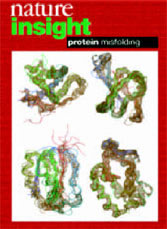At school it all sounded so simple — transcription turns DNA into RNA, and translation of RNA gives you protein. But the often forgotten third step in this process, the folding of the translated linear strand of amino acids into a fully functional three-dimensional protein, is one of the most complex challenges facing the cellular protein factory.
Although it has long been known that the amino-acid sequence in some way dictates the biologically active conformation of a protein, the experimental tools required to probe the intermediate states along the folding pathway have only begun to become available in the past decade or so. These tools are revealing a tightly regulated assembly line, where multiple factors guide nascent proteins to select the correct shape from an almost infinite array of possibilities.
Becoming apparent are the stringent quality-control systems that come into play if the folding process fails, ensuring that the misfolded products are targeted for degradation before they cause harm. Those that escape this cellular surveillance are prone to forming aggregates that can damage or kill cells through mechanisms that are just beginning to be understood.
A huge variety of previously unrelated diseases, such as prion diseases, diabetes and cancer, share the pathological feature of aggregated misfolded protein deposits. This suggests the exciting possibility that these 'protein-misfolding diseases' are linked by common principles, and may therefore present common targets for therapeutic intervention.
The articles in this Insight give an interdisciplinary overview of the field of protein-folding research, treading a path from protein chemistry through cell biology to misfolding diseases and the potential for therapeutic development.
This Insight is entirely self-contained; however, its scope and focus were mirrored in the organization of last year's Horizon Symposium on 'Protein Folding and Disease', the first in a new series of discussion meetings created as a joint initiative by Nature Publishing Group and Aventis. Complementary material can therefore be found at http://www.horizonsymposia.com.
